Evidence Based Nursing Research
VerifiedAdded on 2023/03/30
|12
|2816
|500
AI Summary
This article discusses the importance of evidence based nursing research in promoting influenza vaccination among Aboriginal and Torres Strait Islander children. It explores the study design, participants, intervention, and results, as well as limitations and implications for evidence-based practice.
Contribute Materials
Your contribution can guide someone’s learning journey. Share your
documents today.
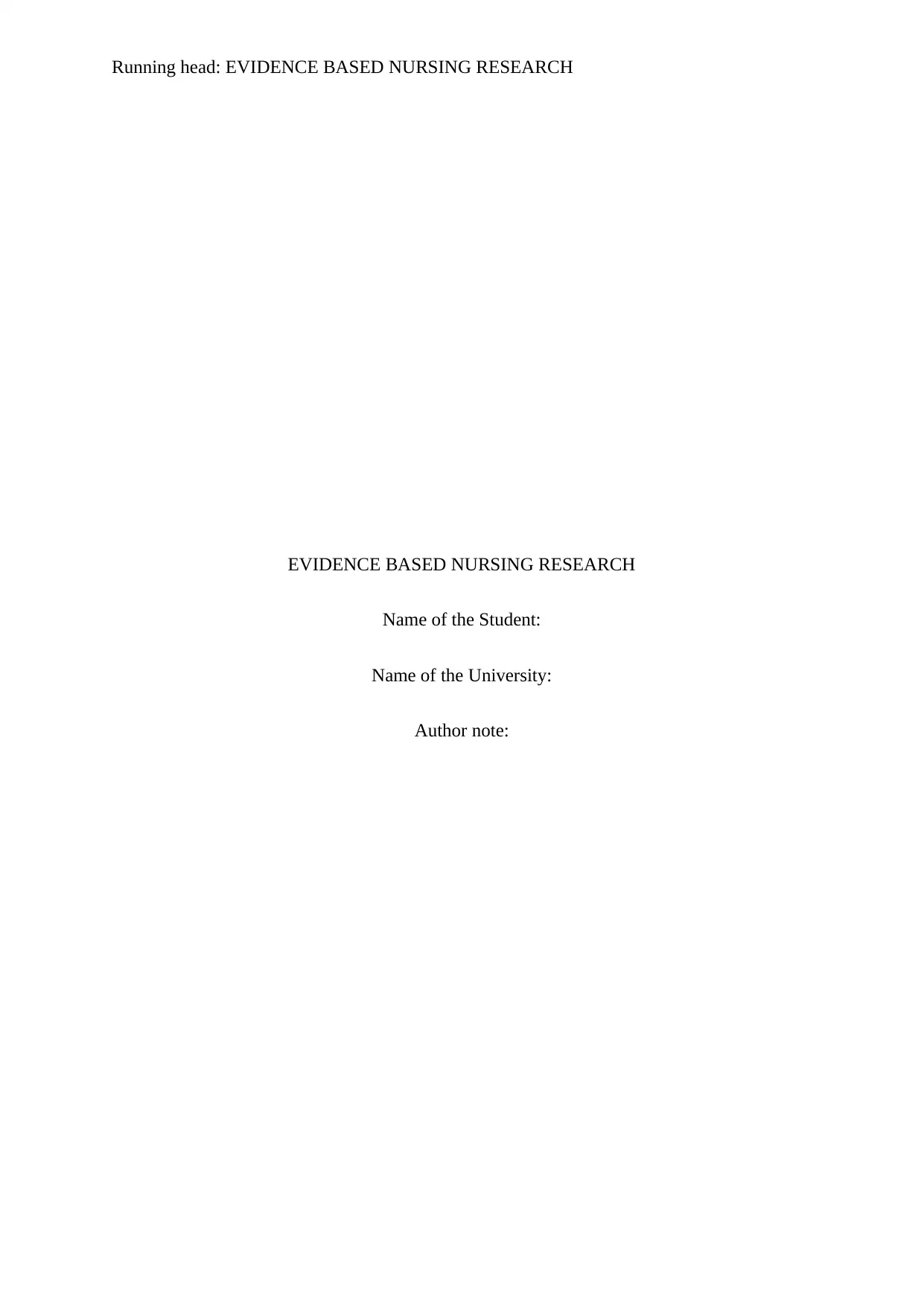
Running head: EVIDENCE BASED NURSING RESEARCH
EVIDENCE BASED NURSING RESEARCH
Name of the Student:
Name of the University:
Author note:
EVIDENCE BASED NURSING RESEARCH
Name of the Student:
Name of the University:
Author note:
Secure Best Marks with AI Grader
Need help grading? Try our AI Grader for instant feedback on your assignments.
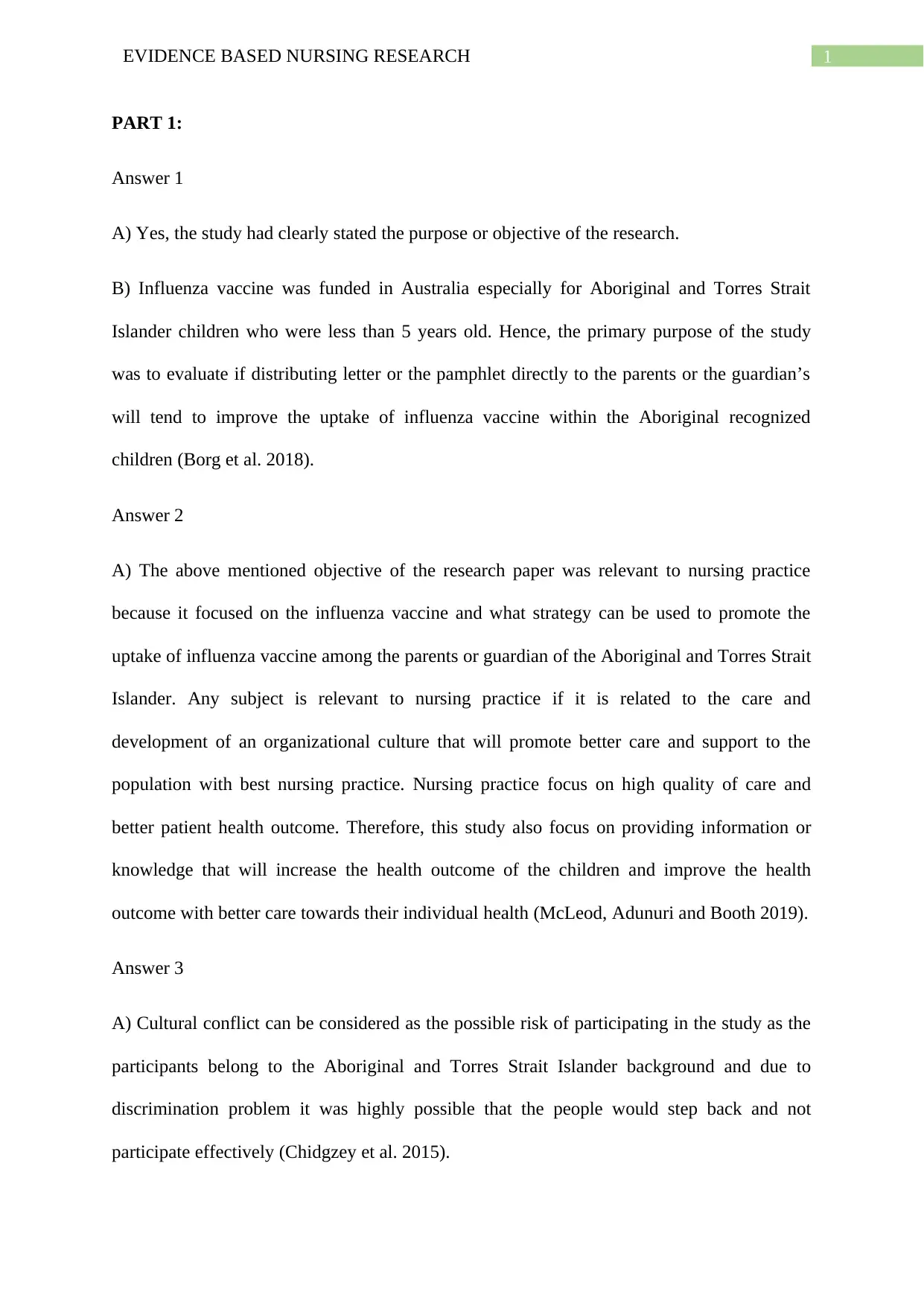
1EVIDENCE BASED NURSING RESEARCH
PART 1:
Answer 1
A) Yes, the study had clearly stated the purpose or objective of the research.
B) Influenza vaccine was funded in Australia especially for Aboriginal and Torres Strait
Islander children who were less than 5 years old. Hence, the primary purpose of the study
was to evaluate if distributing letter or the pamphlet directly to the parents or the guardian’s
will tend to improve the uptake of influenza vaccine within the Aboriginal recognized
children (Borg et al. 2018).
Answer 2
A) The above mentioned objective of the research paper was relevant to nursing practice
because it focused on the influenza vaccine and what strategy can be used to promote the
uptake of influenza vaccine among the parents or guardian of the Aboriginal and Torres Strait
Islander. Any subject is relevant to nursing practice if it is related to the care and
development of an organizational culture that will promote better care and support to the
population with best nursing practice. Nursing practice focus on high quality of care and
better patient health outcome. Therefore, this study also focus on providing information or
knowledge that will increase the health outcome of the children and improve the health
outcome with better care towards their individual health (McLeod, Adunuri and Booth 2019).
Answer 3
A) Cultural conflict can be considered as the possible risk of participating in the study as the
participants belong to the Aboriginal and Torres Strait Islander background and due to
discrimination problem it was highly possible that the people would step back and not
participate effectively (Chidgzey et al. 2015).
PART 1:
Answer 1
A) Yes, the study had clearly stated the purpose or objective of the research.
B) Influenza vaccine was funded in Australia especially for Aboriginal and Torres Strait
Islander children who were less than 5 years old. Hence, the primary purpose of the study
was to evaluate if distributing letter or the pamphlet directly to the parents or the guardian’s
will tend to improve the uptake of influenza vaccine within the Aboriginal recognized
children (Borg et al. 2018).
Answer 2
A) The above mentioned objective of the research paper was relevant to nursing practice
because it focused on the influenza vaccine and what strategy can be used to promote the
uptake of influenza vaccine among the parents or guardian of the Aboriginal and Torres Strait
Islander. Any subject is relevant to nursing practice if it is related to the care and
development of an organizational culture that will promote better care and support to the
population with best nursing practice. Nursing practice focus on high quality of care and
better patient health outcome. Therefore, this study also focus on providing information or
knowledge that will increase the health outcome of the children and improve the health
outcome with better care towards their individual health (McLeod, Adunuri and Booth 2019).
Answer 3
A) Cultural conflict can be considered as the possible risk of participating in the study as the
participants belong to the Aboriginal and Torres Strait Islander background and due to
discrimination problem it was highly possible that the people would step back and not
participate effectively (Chidgzey et al. 2015).
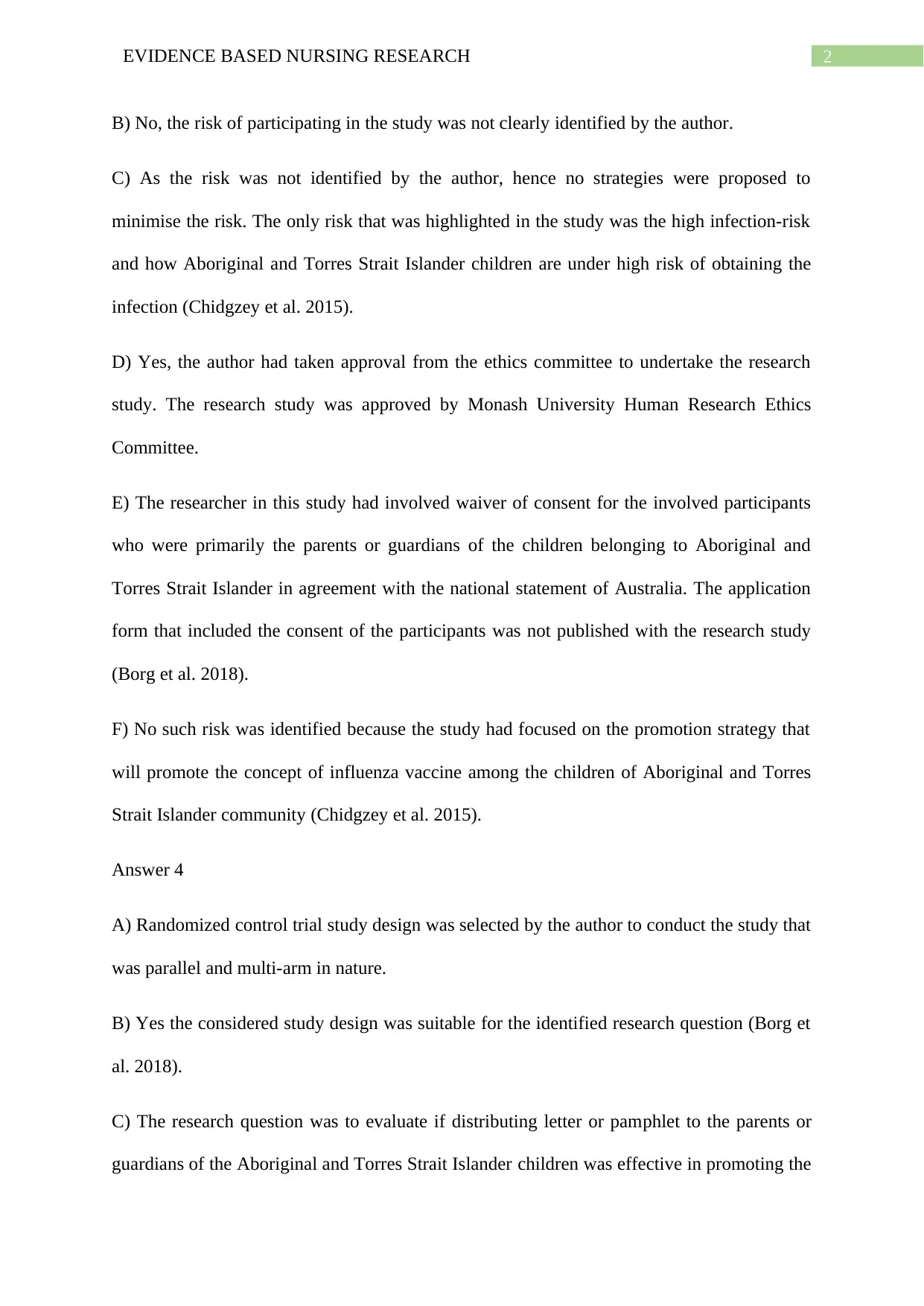
2EVIDENCE BASED NURSING RESEARCH
B) No, the risk of participating in the study was not clearly identified by the author.
C) As the risk was not identified by the author, hence no strategies were proposed to
minimise the risk. The only risk that was highlighted in the study was the high infection-risk
and how Aboriginal and Torres Strait Islander children are under high risk of obtaining the
infection (Chidgzey et al. 2015).
D) Yes, the author had taken approval from the ethics committee to undertake the research
study. The research study was approved by Monash University Human Research Ethics
Committee.
E) The researcher in this study had involved waiver of consent for the involved participants
who were primarily the parents or guardians of the children belonging to Aboriginal and
Torres Strait Islander in agreement with the national statement of Australia. The application
form that included the consent of the participants was not published with the research study
(Borg et al. 2018).
F) No such risk was identified because the study had focused on the promotion strategy that
will promote the concept of influenza vaccine among the children of Aboriginal and Torres
Strait Islander community (Chidgzey et al. 2015).
Answer 4
A) Randomized control trial study design was selected by the author to conduct the study that
was parallel and multi-arm in nature.
B) Yes the considered study design was suitable for the identified research question (Borg et
al. 2018).
C) The research question was to evaluate if distributing letter or pamphlet to the parents or
guardians of the Aboriginal and Torres Strait Islander children was effective in promoting the
B) No, the risk of participating in the study was not clearly identified by the author.
C) As the risk was not identified by the author, hence no strategies were proposed to
minimise the risk. The only risk that was highlighted in the study was the high infection-risk
and how Aboriginal and Torres Strait Islander children are under high risk of obtaining the
infection (Chidgzey et al. 2015).
D) Yes, the author had taken approval from the ethics committee to undertake the research
study. The research study was approved by Monash University Human Research Ethics
Committee.
E) The researcher in this study had involved waiver of consent for the involved participants
who were primarily the parents or guardians of the children belonging to Aboriginal and
Torres Strait Islander in agreement with the national statement of Australia. The application
form that included the consent of the participants was not published with the research study
(Borg et al. 2018).
F) No such risk was identified because the study had focused on the promotion strategy that
will promote the concept of influenza vaccine among the children of Aboriginal and Torres
Strait Islander community (Chidgzey et al. 2015).
Answer 4
A) Randomized control trial study design was selected by the author to conduct the study that
was parallel and multi-arm in nature.
B) Yes the considered study design was suitable for the identified research question (Borg et
al. 2018).
C) The research question was to evaluate if distributing letter or pamphlet to the parents or
guardians of the Aboriginal and Torres Strait Islander children was effective in promoting the
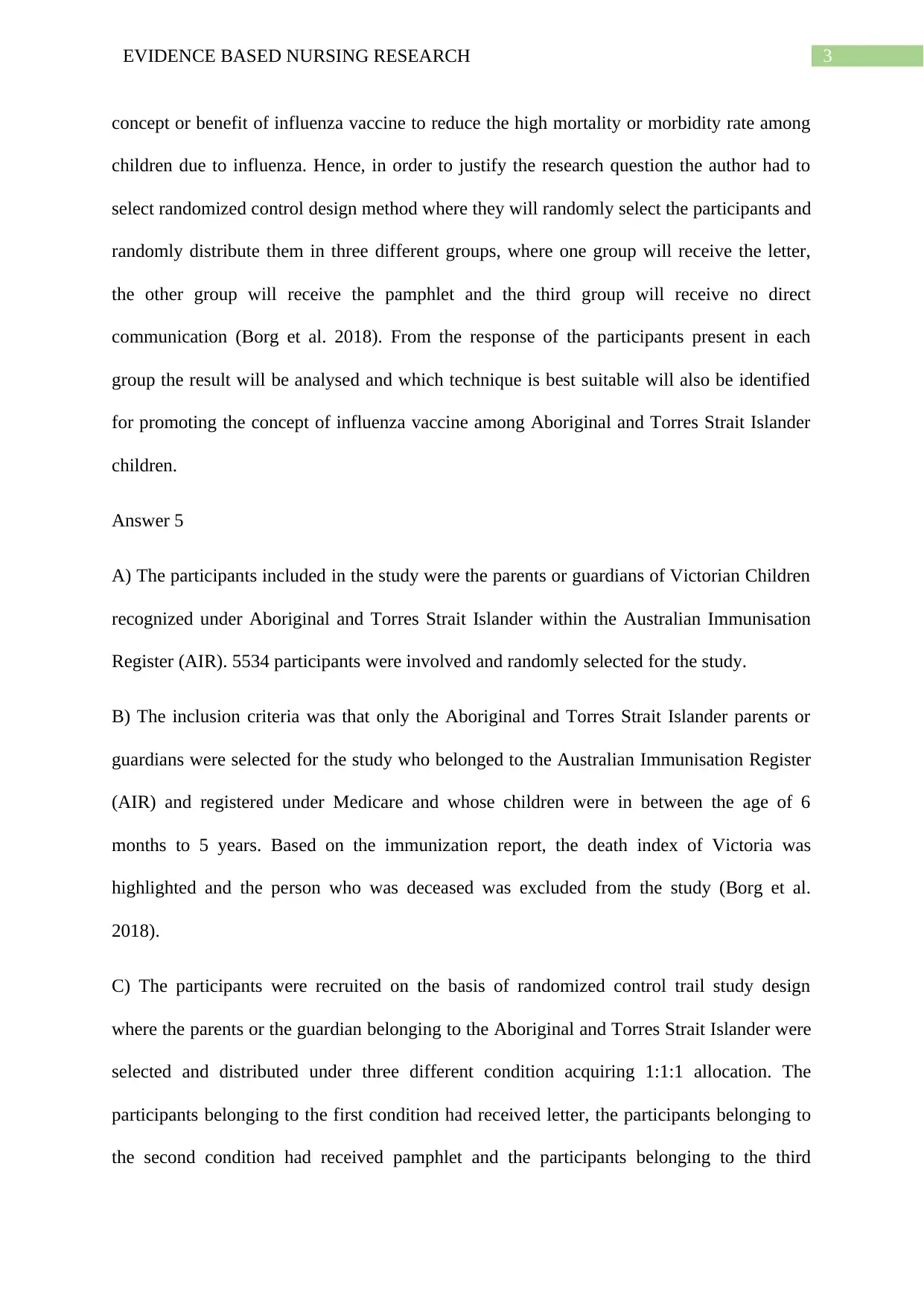
3EVIDENCE BASED NURSING RESEARCH
concept or benefit of influenza vaccine to reduce the high mortality or morbidity rate among
children due to influenza. Hence, in order to justify the research question the author had to
select randomized control design method where they will randomly select the participants and
randomly distribute them in three different groups, where one group will receive the letter,
the other group will receive the pamphlet and the third group will receive no direct
communication (Borg et al. 2018). From the response of the participants present in each
group the result will be analysed and which technique is best suitable will also be identified
for promoting the concept of influenza vaccine among Aboriginal and Torres Strait Islander
children.
Answer 5
A) The participants included in the study were the parents or guardians of Victorian Children
recognized under Aboriginal and Torres Strait Islander within the Australian Immunisation
Register (AIR). 5534 participants were involved and randomly selected for the study.
B) The inclusion criteria was that only the Aboriginal and Torres Strait Islander parents or
guardians were selected for the study who belonged to the Australian Immunisation Register
(AIR) and registered under Medicare and whose children were in between the age of 6
months to 5 years. Based on the immunization report, the death index of Victoria was
highlighted and the person who was deceased was excluded from the study (Borg et al.
2018).
C) The participants were recruited on the basis of randomized control trail study design
where the parents or the guardian belonging to the Aboriginal and Torres Strait Islander were
selected and distributed under three different condition acquiring 1:1:1 allocation. The
participants belonging to the first condition had received letter, the participants belonging to
the second condition had received pamphlet and the participants belonging to the third
concept or benefit of influenza vaccine to reduce the high mortality or morbidity rate among
children due to influenza. Hence, in order to justify the research question the author had to
select randomized control design method where they will randomly select the participants and
randomly distribute them in three different groups, where one group will receive the letter,
the other group will receive the pamphlet and the third group will receive no direct
communication (Borg et al. 2018). From the response of the participants present in each
group the result will be analysed and which technique is best suitable will also be identified
for promoting the concept of influenza vaccine among Aboriginal and Torres Strait Islander
children.
Answer 5
A) The participants included in the study were the parents or guardians of Victorian Children
recognized under Aboriginal and Torres Strait Islander within the Australian Immunisation
Register (AIR). 5534 participants were involved and randomly selected for the study.
B) The inclusion criteria was that only the Aboriginal and Torres Strait Islander parents or
guardians were selected for the study who belonged to the Australian Immunisation Register
(AIR) and registered under Medicare and whose children were in between the age of 6
months to 5 years. Based on the immunization report, the death index of Victoria was
highlighted and the person who was deceased was excluded from the study (Borg et al.
2018).
C) The participants were recruited on the basis of randomized control trail study design
where the parents or the guardian belonging to the Aboriginal and Torres Strait Islander were
selected and distributed under three different condition acquiring 1:1:1 allocation. The
participants belonging to the first condition had received letter, the participants belonging to
the second condition had received pamphlet and the participants belonging to the third
Secure Best Marks with AI Grader
Need help grading? Try our AI Grader for instant feedback on your assignments.
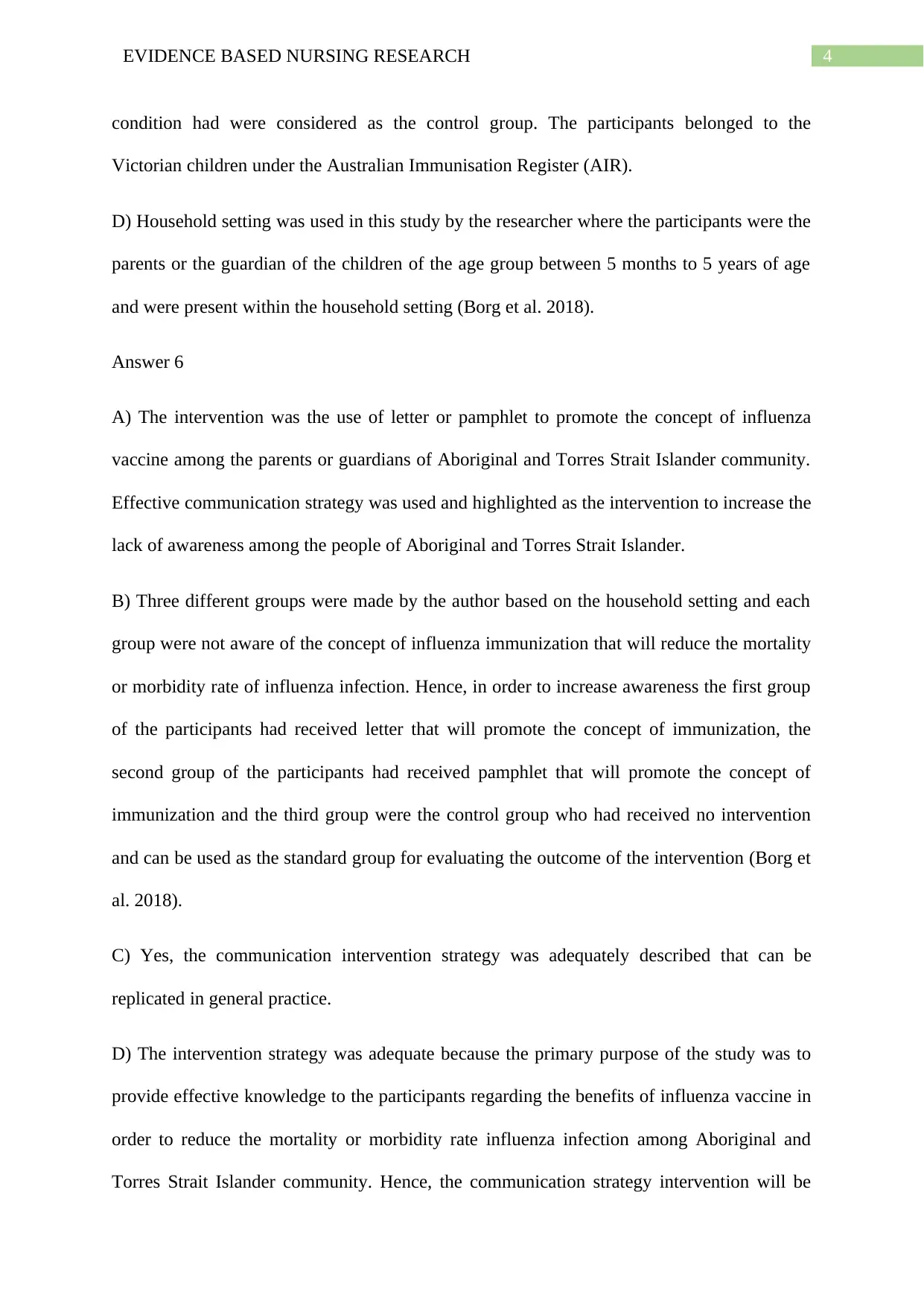
4EVIDENCE BASED NURSING RESEARCH
condition had were considered as the control group. The participants belonged to the
Victorian children under the Australian Immunisation Register (AIR).
D) Household setting was used in this study by the researcher where the participants were the
parents or the guardian of the children of the age group between 5 months to 5 years of age
and were present within the household setting (Borg et al. 2018).
Answer 6
A) The intervention was the use of letter or pamphlet to promote the concept of influenza
vaccine among the parents or guardians of Aboriginal and Torres Strait Islander community.
Effective communication strategy was used and highlighted as the intervention to increase the
lack of awareness among the people of Aboriginal and Torres Strait Islander.
B) Three different groups were made by the author based on the household setting and each
group were not aware of the concept of influenza immunization that will reduce the mortality
or morbidity rate of influenza infection. Hence, in order to increase awareness the first group
of the participants had received letter that will promote the concept of immunization, the
second group of the participants had received pamphlet that will promote the concept of
immunization and the third group were the control group who had received no intervention
and can be used as the standard group for evaluating the outcome of the intervention (Borg et
al. 2018).
C) Yes, the communication intervention strategy was adequately described that can be
replicated in general practice.
D) The intervention strategy was adequate because the primary purpose of the study was to
provide effective knowledge to the participants regarding the benefits of influenza vaccine in
order to reduce the mortality or morbidity rate influenza infection among Aboriginal and
Torres Strait Islander community. Hence, the communication strategy intervention will be
condition had were considered as the control group. The participants belonged to the
Victorian children under the Australian Immunisation Register (AIR).
D) Household setting was used in this study by the researcher where the participants were the
parents or the guardian of the children of the age group between 5 months to 5 years of age
and were present within the household setting (Borg et al. 2018).
Answer 6
A) The intervention was the use of letter or pamphlet to promote the concept of influenza
vaccine among the parents or guardians of Aboriginal and Torres Strait Islander community.
Effective communication strategy was used and highlighted as the intervention to increase the
lack of awareness among the people of Aboriginal and Torres Strait Islander.
B) Three different groups were made by the author based on the household setting and each
group were not aware of the concept of influenza immunization that will reduce the mortality
or morbidity rate of influenza infection. Hence, in order to increase awareness the first group
of the participants had received letter that will promote the concept of immunization, the
second group of the participants had received pamphlet that will promote the concept of
immunization and the third group were the control group who had received no intervention
and can be used as the standard group for evaluating the outcome of the intervention (Borg et
al. 2018).
C) Yes, the communication intervention strategy was adequately described that can be
replicated in general practice.
D) The intervention strategy was adequate because the primary purpose of the study was to
provide effective knowledge to the participants regarding the benefits of influenza vaccine in
order to reduce the mortality or morbidity rate influenza infection among Aboriginal and
Torres Strait Islander community. Hence, the communication strategy intervention will be
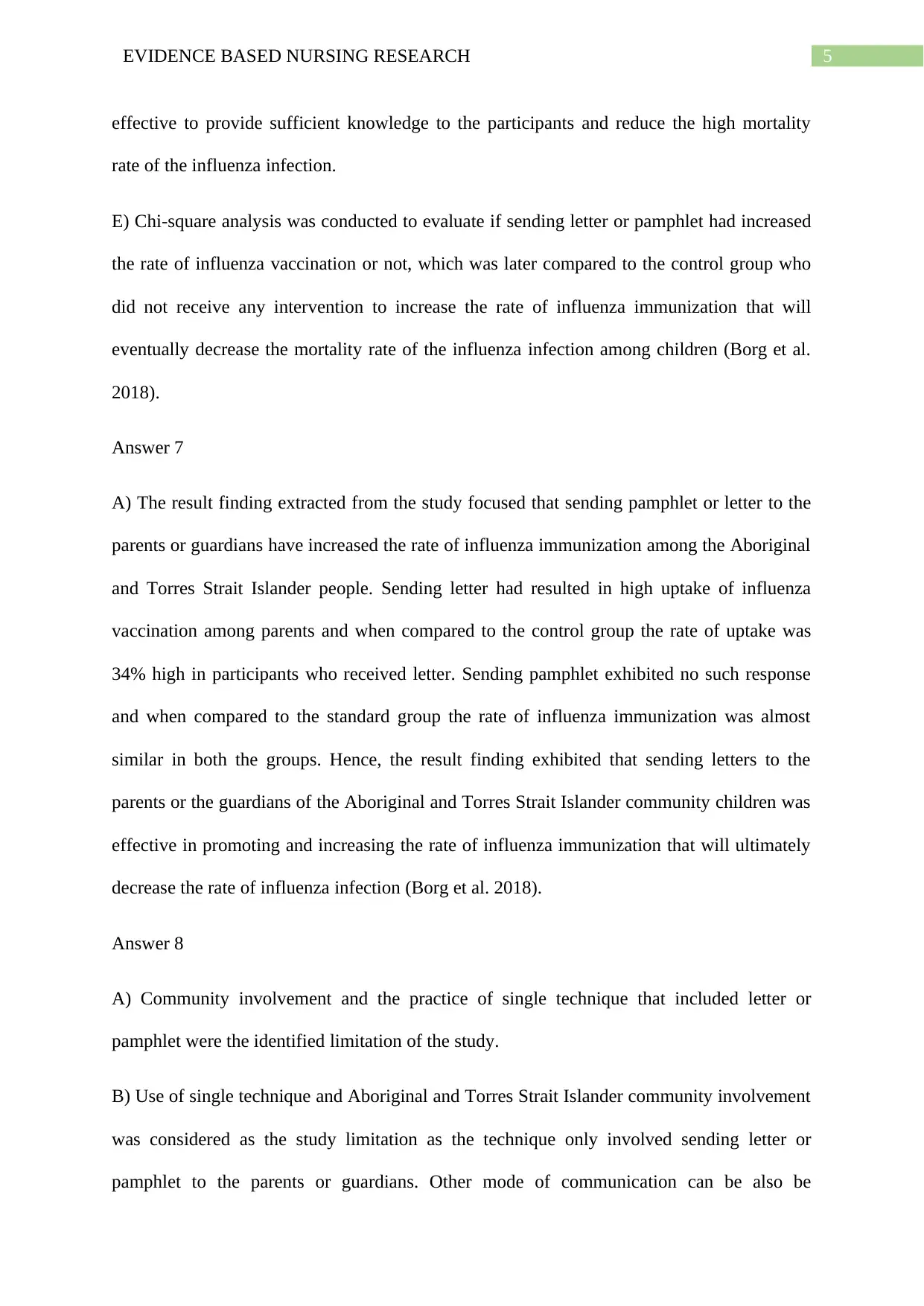
5EVIDENCE BASED NURSING RESEARCH
effective to provide sufficient knowledge to the participants and reduce the high mortality
rate of the influenza infection.
E) Chi-square analysis was conducted to evaluate if sending letter or pamphlet had increased
the rate of influenza vaccination or not, which was later compared to the control group who
did not receive any intervention to increase the rate of influenza immunization that will
eventually decrease the mortality rate of the influenza infection among children (Borg et al.
2018).
Answer 7
A) The result finding extracted from the study focused that sending pamphlet or letter to the
parents or guardians have increased the rate of influenza immunization among the Aboriginal
and Torres Strait Islander people. Sending letter had resulted in high uptake of influenza
vaccination among parents and when compared to the control group the rate of uptake was
34% high in participants who received letter. Sending pamphlet exhibited no such response
and when compared to the standard group the rate of influenza immunization was almost
similar in both the groups. Hence, the result finding exhibited that sending letters to the
parents or the guardians of the Aboriginal and Torres Strait Islander community children was
effective in promoting and increasing the rate of influenza immunization that will ultimately
decrease the rate of influenza infection (Borg et al. 2018).
Answer 8
A) Community involvement and the practice of single technique that included letter or
pamphlet were the identified limitation of the study.
B) Use of single technique and Aboriginal and Torres Strait Islander community involvement
was considered as the study limitation as the technique only involved sending letter or
pamphlet to the parents or guardians. Other mode of communication can be also be
effective to provide sufficient knowledge to the participants and reduce the high mortality
rate of the influenza infection.
E) Chi-square analysis was conducted to evaluate if sending letter or pamphlet had increased
the rate of influenza vaccination or not, which was later compared to the control group who
did not receive any intervention to increase the rate of influenza immunization that will
eventually decrease the mortality rate of the influenza infection among children (Borg et al.
2018).
Answer 7
A) The result finding extracted from the study focused that sending pamphlet or letter to the
parents or guardians have increased the rate of influenza immunization among the Aboriginal
and Torres Strait Islander people. Sending letter had resulted in high uptake of influenza
vaccination among parents and when compared to the control group the rate of uptake was
34% high in participants who received letter. Sending pamphlet exhibited no such response
and when compared to the standard group the rate of influenza immunization was almost
similar in both the groups. Hence, the result finding exhibited that sending letters to the
parents or the guardians of the Aboriginal and Torres Strait Islander community children was
effective in promoting and increasing the rate of influenza immunization that will ultimately
decrease the rate of influenza infection (Borg et al. 2018).
Answer 8
A) Community involvement and the practice of single technique that included letter or
pamphlet were the identified limitation of the study.
B) Use of single technique and Aboriginal and Torres Strait Islander community involvement
was considered as the study limitation as the technique only involved sending letter or
pamphlet to the parents or guardians. Other mode of communication can be also be
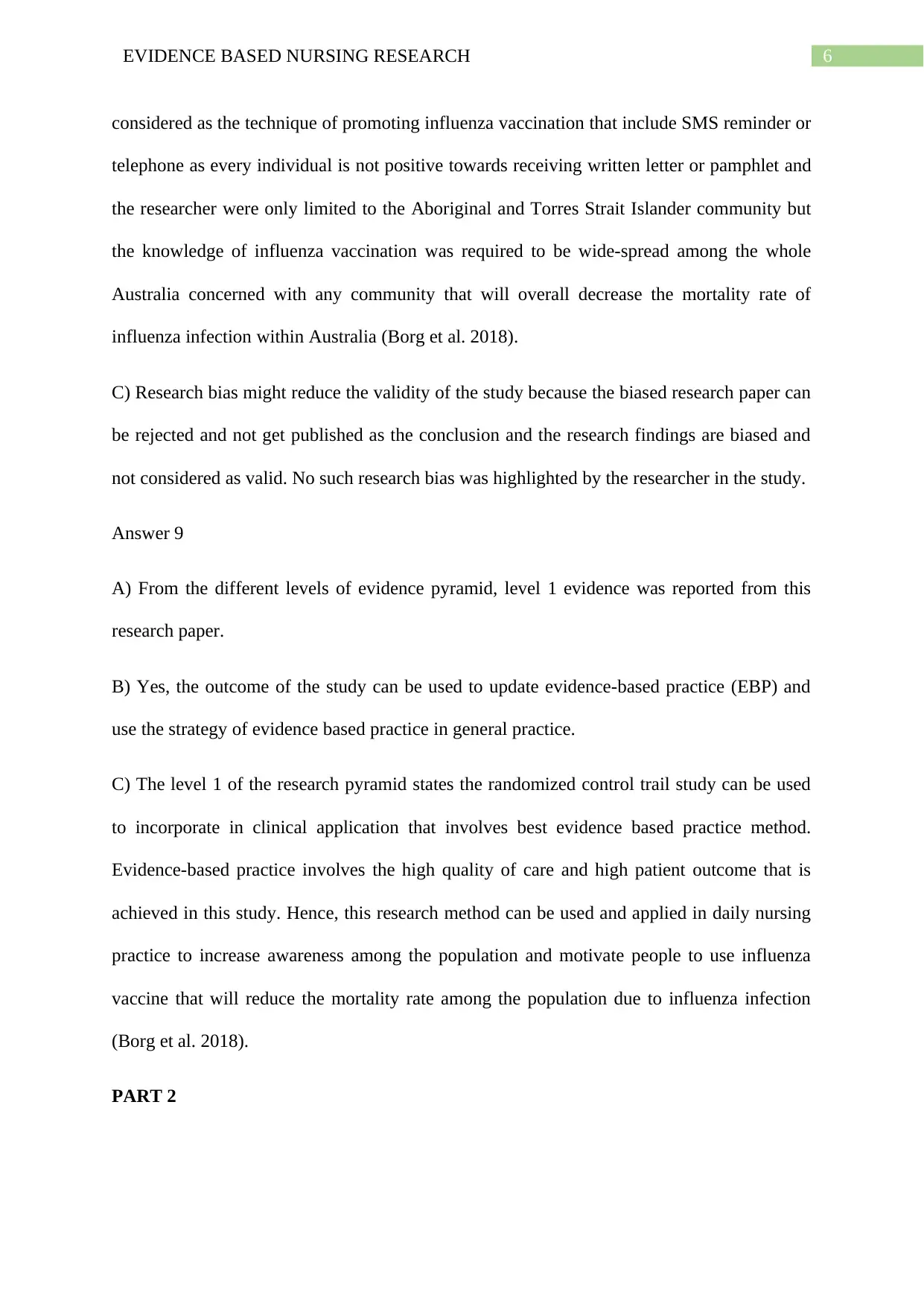
6EVIDENCE BASED NURSING RESEARCH
considered as the technique of promoting influenza vaccination that include SMS reminder or
telephone as every individual is not positive towards receiving written letter or pamphlet and
the researcher were only limited to the Aboriginal and Torres Strait Islander community but
the knowledge of influenza vaccination was required to be wide-spread among the whole
Australia concerned with any community that will overall decrease the mortality rate of
influenza infection within Australia (Borg et al. 2018).
C) Research bias might reduce the validity of the study because the biased research paper can
be rejected and not get published as the conclusion and the research findings are biased and
not considered as valid. No such research bias was highlighted by the researcher in the study.
Answer 9
A) From the different levels of evidence pyramid, level 1 evidence was reported from this
research paper.
B) Yes, the outcome of the study can be used to update evidence-based practice (EBP) and
use the strategy of evidence based practice in general practice.
C) The level 1 of the research pyramid states the randomized control trail study can be used
to incorporate in clinical application that involves best evidence based practice method.
Evidence-based practice involves the high quality of care and high patient outcome that is
achieved in this study. Hence, this research method can be used and applied in daily nursing
practice to increase awareness among the population and motivate people to use influenza
vaccine that will reduce the mortality rate among the population due to influenza infection
(Borg et al. 2018).
PART 2
considered as the technique of promoting influenza vaccination that include SMS reminder or
telephone as every individual is not positive towards receiving written letter or pamphlet and
the researcher were only limited to the Aboriginal and Torres Strait Islander community but
the knowledge of influenza vaccination was required to be wide-spread among the whole
Australia concerned with any community that will overall decrease the mortality rate of
influenza infection within Australia (Borg et al. 2018).
C) Research bias might reduce the validity of the study because the biased research paper can
be rejected and not get published as the conclusion and the research findings are biased and
not considered as valid. No such research bias was highlighted by the researcher in the study.
Answer 9
A) From the different levels of evidence pyramid, level 1 evidence was reported from this
research paper.
B) Yes, the outcome of the study can be used to update evidence-based practice (EBP) and
use the strategy of evidence based practice in general practice.
C) The level 1 of the research pyramid states the randomized control trail study can be used
to incorporate in clinical application that involves best evidence based practice method.
Evidence-based practice involves the high quality of care and high patient outcome that is
achieved in this study. Hence, this research method can be used and applied in daily nursing
practice to increase awareness among the population and motivate people to use influenza
vaccine that will reduce the mortality rate among the population due to influenza infection
(Borg et al. 2018).
PART 2
Paraphrase This Document
Need a fresh take? Get an instant paraphrase of this document with our AI Paraphraser
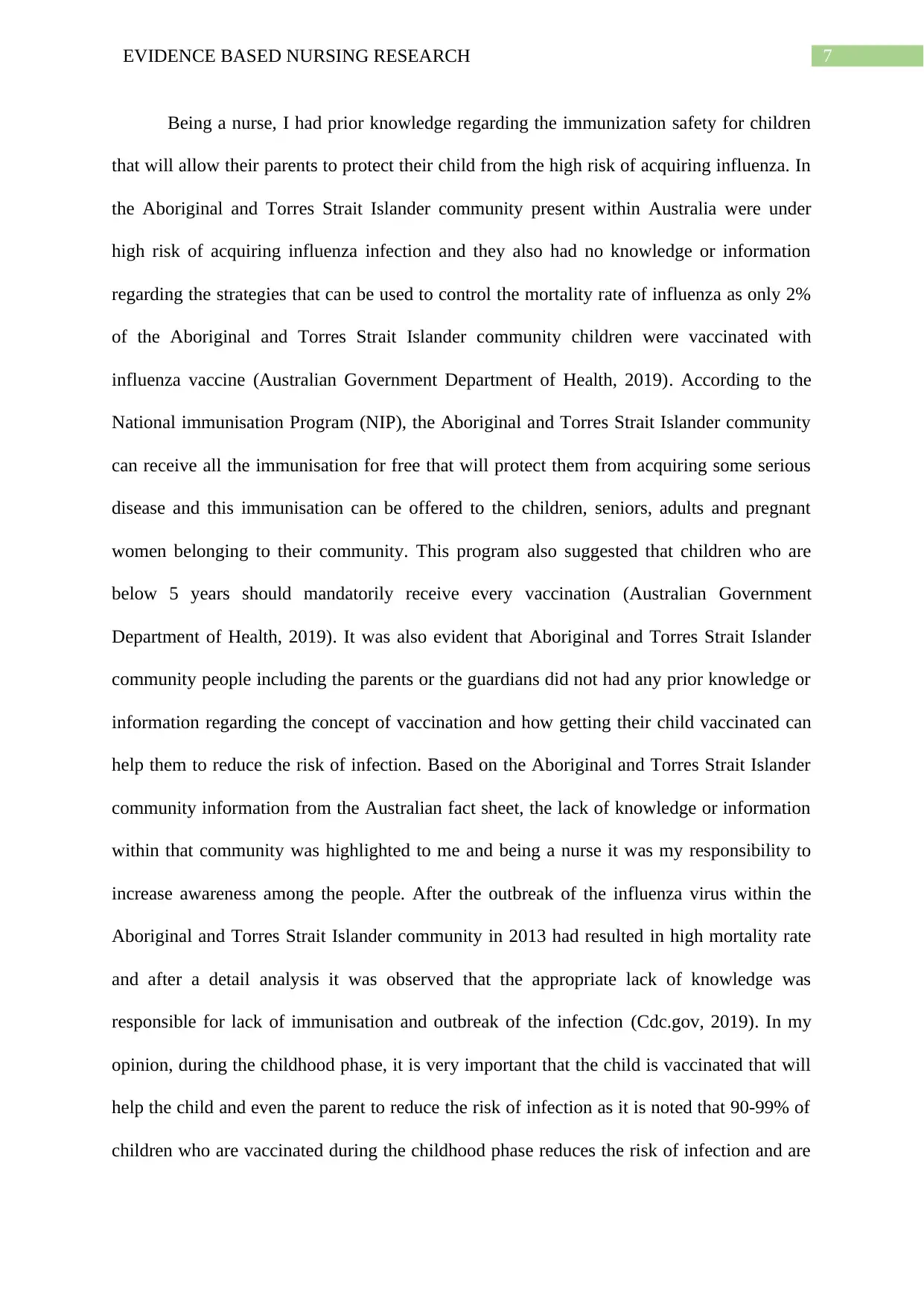
7EVIDENCE BASED NURSING RESEARCH
Being a nurse, I had prior knowledge regarding the immunization safety for children
that will allow their parents to protect their child from the high risk of acquiring influenza. In
the Aboriginal and Torres Strait Islander community present within Australia were under
high risk of acquiring influenza infection and they also had no knowledge or information
regarding the strategies that can be used to control the mortality rate of influenza as only 2%
of the Aboriginal and Torres Strait Islander community children were vaccinated with
influenza vaccine (Australian Government Department of Health, 2019). According to the
National immunisation Program (NIP), the Aboriginal and Torres Strait Islander community
can receive all the immunisation for free that will protect them from acquiring some serious
disease and this immunisation can be offered to the children, seniors, adults and pregnant
women belonging to their community. This program also suggested that children who are
below 5 years should mandatorily receive every vaccination (Australian Government
Department of Health, 2019). It was also evident that Aboriginal and Torres Strait Islander
community people including the parents or the guardians did not had any prior knowledge or
information regarding the concept of vaccination and how getting their child vaccinated can
help them to reduce the risk of infection. Based on the Aboriginal and Torres Strait Islander
community information from the Australian fact sheet, the lack of knowledge or information
within that community was highlighted to me and being a nurse it was my responsibility to
increase awareness among the people. After the outbreak of the influenza virus within the
Aboriginal and Torres Strait Islander community in 2013 had resulted in high mortality rate
and after a detail analysis it was observed that the appropriate lack of knowledge was
responsible for lack of immunisation and outbreak of the infection (Cdc.gov, 2019). In my
opinion, during the childhood phase, it is very important that the child is vaccinated that will
help the child and even the parent to reduce the risk of infection as it is noted that 90-99% of
children who are vaccinated during the childhood phase reduces the risk of infection and are
Being a nurse, I had prior knowledge regarding the immunization safety for children
that will allow their parents to protect their child from the high risk of acquiring influenza. In
the Aboriginal and Torres Strait Islander community present within Australia were under
high risk of acquiring influenza infection and they also had no knowledge or information
regarding the strategies that can be used to control the mortality rate of influenza as only 2%
of the Aboriginal and Torres Strait Islander community children were vaccinated with
influenza vaccine (Australian Government Department of Health, 2019). According to the
National immunisation Program (NIP), the Aboriginal and Torres Strait Islander community
can receive all the immunisation for free that will protect them from acquiring some serious
disease and this immunisation can be offered to the children, seniors, adults and pregnant
women belonging to their community. This program also suggested that children who are
below 5 years should mandatorily receive every vaccination (Australian Government
Department of Health, 2019). It was also evident that Aboriginal and Torres Strait Islander
community people including the parents or the guardians did not had any prior knowledge or
information regarding the concept of vaccination and how getting their child vaccinated can
help them to reduce the risk of infection. Based on the Aboriginal and Torres Strait Islander
community information from the Australian fact sheet, the lack of knowledge or information
within that community was highlighted to me and being a nurse it was my responsibility to
increase awareness among the people. After the outbreak of the influenza virus within the
Aboriginal and Torres Strait Islander community in 2013 had resulted in high mortality rate
and after a detail analysis it was observed that the appropriate lack of knowledge was
responsible for lack of immunisation and outbreak of the infection (Cdc.gov, 2019). In my
opinion, during the childhood phase, it is very important that the child is vaccinated that will
help the child and even the parent to reduce the risk of infection as it is noted that 90-99% of
children who are vaccinated during the childhood phase reduces the risk of infection and are
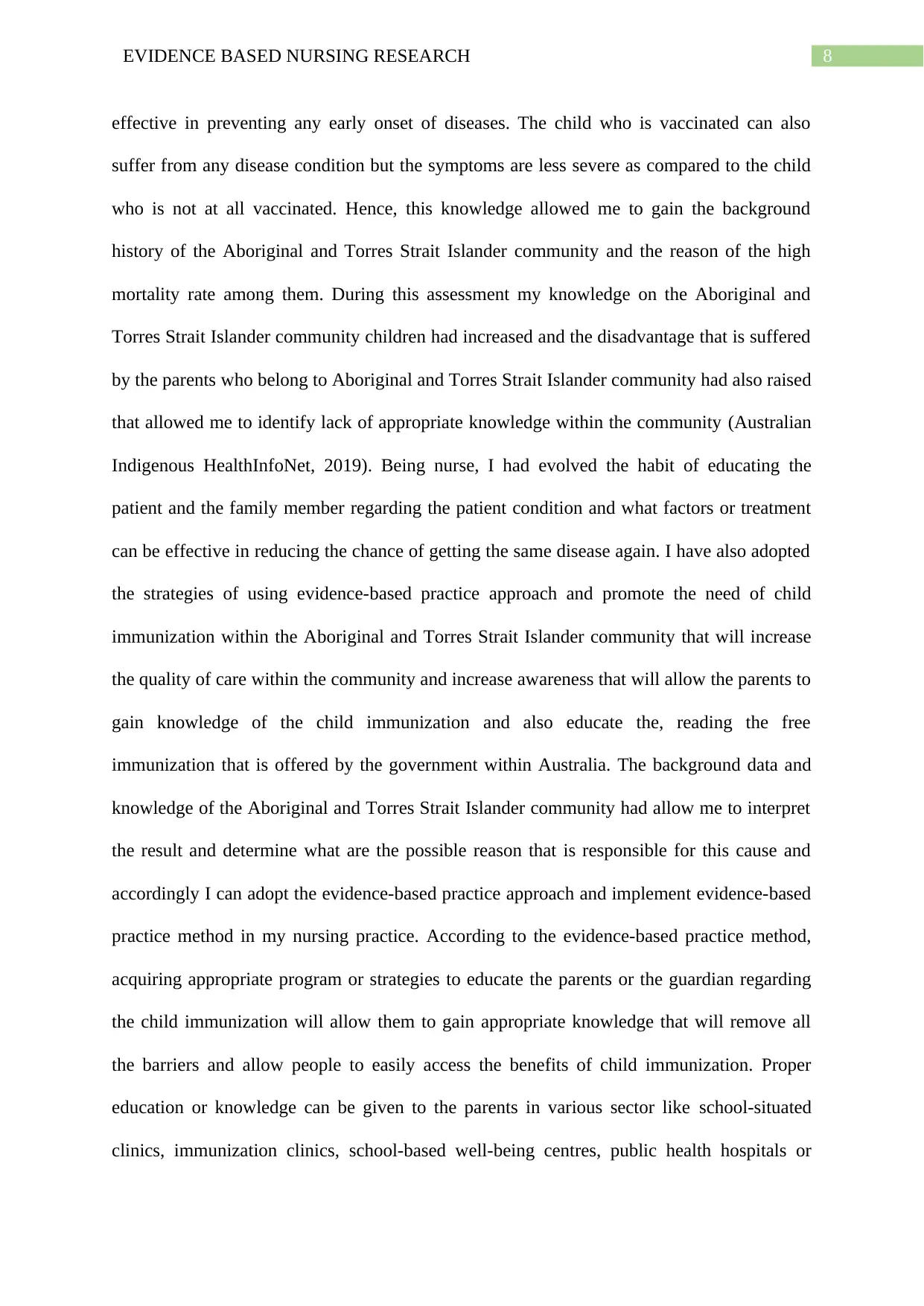
8EVIDENCE BASED NURSING RESEARCH
effective in preventing any early onset of diseases. The child who is vaccinated can also
suffer from any disease condition but the symptoms are less severe as compared to the child
who is not at all vaccinated. Hence, this knowledge allowed me to gain the background
history of the Aboriginal and Torres Strait Islander community and the reason of the high
mortality rate among them. During this assessment my knowledge on the Aboriginal and
Torres Strait Islander community children had increased and the disadvantage that is suffered
by the parents who belong to Aboriginal and Torres Strait Islander community had also raised
that allowed me to identify lack of appropriate knowledge within the community (Australian
Indigenous HealthInfoNet, 2019). Being nurse, I had evolved the habit of educating the
patient and the family member regarding the patient condition and what factors or treatment
can be effective in reducing the chance of getting the same disease again. I have also adopted
the strategies of using evidence-based practice approach and promote the need of child
immunization within the Aboriginal and Torres Strait Islander community that will increase
the quality of care within the community and increase awareness that will allow the parents to
gain knowledge of the child immunization and also educate the, reading the free
immunization that is offered by the government within Australia. The background data and
knowledge of the Aboriginal and Torres Strait Islander community had allow me to interpret
the result and determine what are the possible reason that is responsible for this cause and
accordingly I can adopt the evidence-based practice approach and implement evidence-based
practice method in my nursing practice. According to the evidence-based practice method,
acquiring appropriate program or strategies to educate the parents or the guardian regarding
the child immunization will allow them to gain appropriate knowledge that will remove all
the barriers and allow people to easily access the benefits of child immunization. Proper
education or knowledge can be given to the parents in various sector like school-situated
clinics, immunization clinics, school-based well-being centres, public health hospitals or
effective in preventing any early onset of diseases. The child who is vaccinated can also
suffer from any disease condition but the symptoms are less severe as compared to the child
who is not at all vaccinated. Hence, this knowledge allowed me to gain the background
history of the Aboriginal and Torres Strait Islander community and the reason of the high
mortality rate among them. During this assessment my knowledge on the Aboriginal and
Torres Strait Islander community children had increased and the disadvantage that is suffered
by the parents who belong to Aboriginal and Torres Strait Islander community had also raised
that allowed me to identify lack of appropriate knowledge within the community (Australian
Indigenous HealthInfoNet, 2019). Being nurse, I had evolved the habit of educating the
patient and the family member regarding the patient condition and what factors or treatment
can be effective in reducing the chance of getting the same disease again. I have also adopted
the strategies of using evidence-based practice approach and promote the need of child
immunization within the Aboriginal and Torres Strait Islander community that will increase
the quality of care within the community and increase awareness that will allow the parents to
gain knowledge of the child immunization and also educate the, reading the free
immunization that is offered by the government within Australia. The background data and
knowledge of the Aboriginal and Torres Strait Islander community had allow me to interpret
the result and determine what are the possible reason that is responsible for this cause and
accordingly I can adopt the evidence-based practice approach and implement evidence-based
practice method in my nursing practice. According to the evidence-based practice method,
acquiring appropriate program or strategies to educate the parents or the guardian regarding
the child immunization will allow them to gain appropriate knowledge that will remove all
the barriers and allow people to easily access the benefits of child immunization. Proper
education or knowledge can be given to the parents in various sector like school-situated
clinics, immunization clinics, school-based well-being centres, public health hospitals or
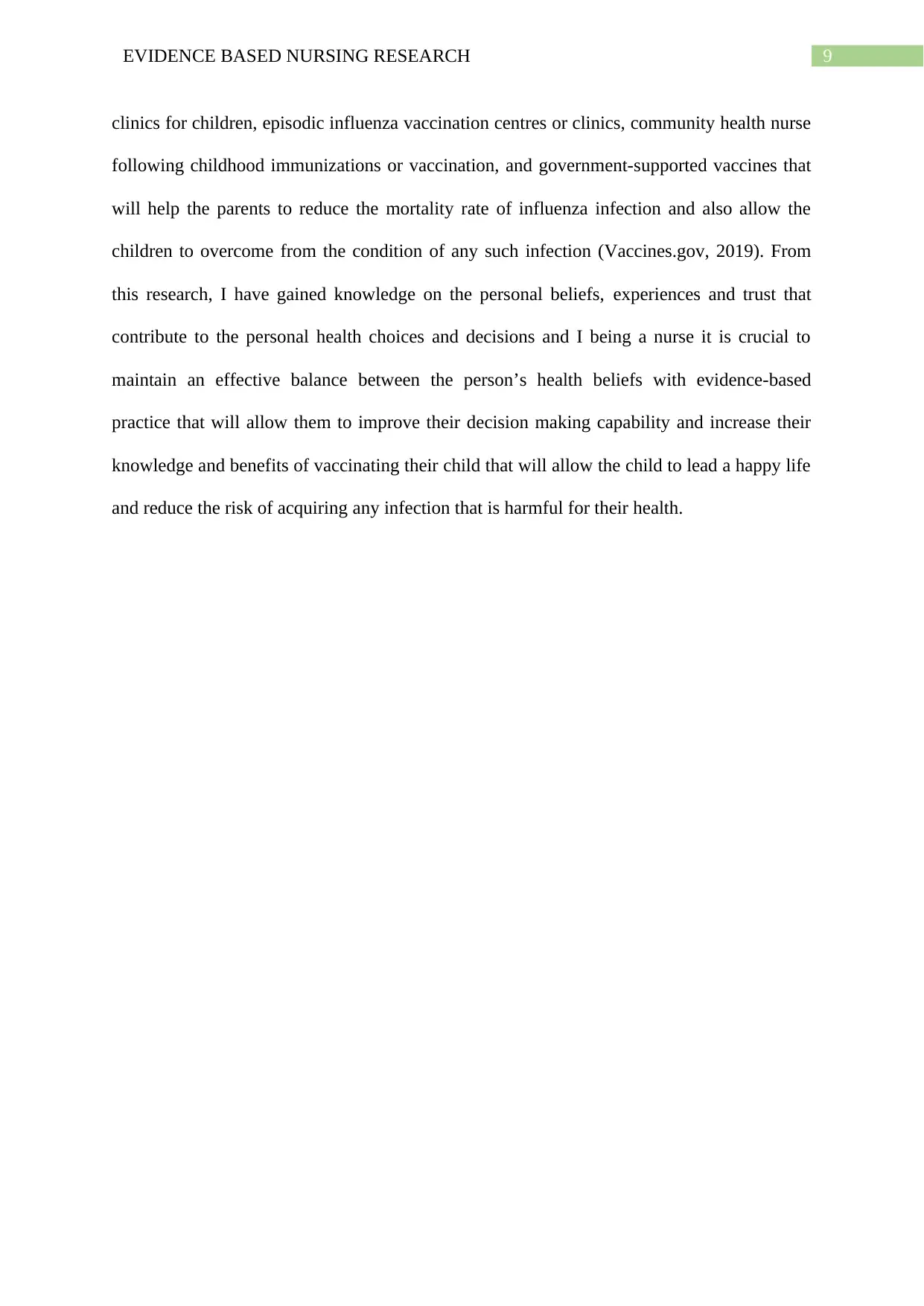
9EVIDENCE BASED NURSING RESEARCH
clinics for children, episodic influenza vaccination centres or clinics, community health nurse
following childhood immunizations or vaccination, and government-supported vaccines that
will help the parents to reduce the mortality rate of influenza infection and also allow the
children to overcome from the condition of any such infection (Vaccines.gov, 2019). From
this research, I have gained knowledge on the personal beliefs, experiences and trust that
contribute to the personal health choices and decisions and I being a nurse it is crucial to
maintain an effective balance between the person’s health beliefs with evidence-based
practice that will allow them to improve their decision making capability and increase their
knowledge and benefits of vaccinating their child that will allow the child to lead a happy life
and reduce the risk of acquiring any infection that is harmful for their health.
clinics for children, episodic influenza vaccination centres or clinics, community health nurse
following childhood immunizations or vaccination, and government-supported vaccines that
will help the parents to reduce the mortality rate of influenza infection and also allow the
children to overcome from the condition of any such infection (Vaccines.gov, 2019). From
this research, I have gained knowledge on the personal beliefs, experiences and trust that
contribute to the personal health choices and decisions and I being a nurse it is crucial to
maintain an effective balance between the person’s health beliefs with evidence-based
practice that will allow them to improve their decision making capability and increase their
knowledge and benefits of vaccinating their child that will allow the child to lead a happy life
and reduce the risk of acquiring any infection that is harmful for their health.
Secure Best Marks with AI Grader
Need help grading? Try our AI Grader for instant feedback on your assignments.
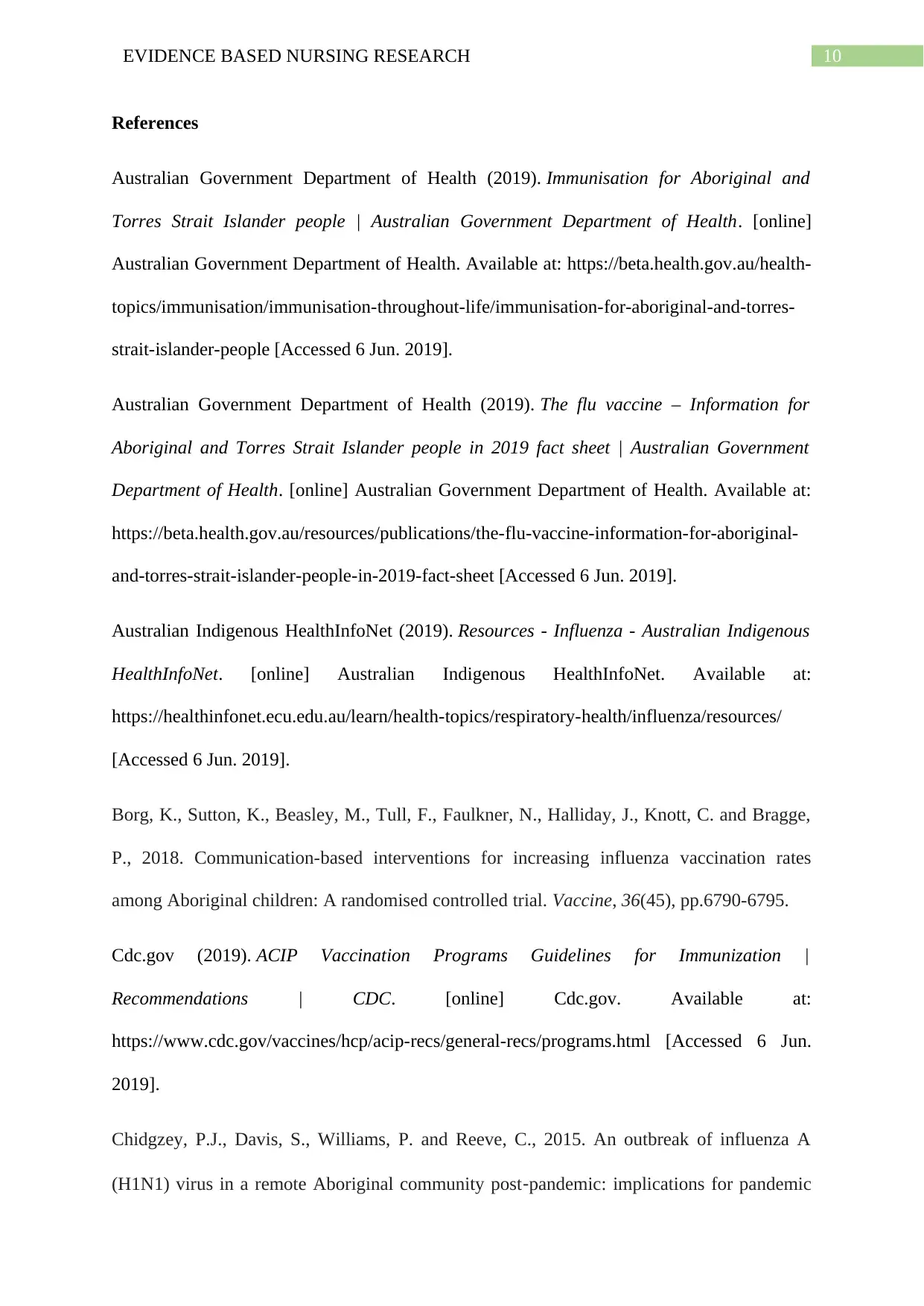
10EVIDENCE BASED NURSING RESEARCH
References
Australian Government Department of Health (2019). Immunisation for Aboriginal and
Torres Strait Islander people | Australian Government Department of Health. [online]
Australian Government Department of Health. Available at: https://beta.health.gov.au/health-
topics/immunisation/immunisation-throughout-life/immunisation-for-aboriginal-and-torres-
strait-islander-people [Accessed 6 Jun. 2019].
Australian Government Department of Health (2019). The flu vaccine – Information for
Aboriginal and Torres Strait Islander people in 2019 fact sheet | Australian Government
Department of Health. [online] Australian Government Department of Health. Available at:
https://beta.health.gov.au/resources/publications/the-flu-vaccine-information-for-aboriginal-
and-torres-strait-islander-people-in-2019-fact-sheet [Accessed 6 Jun. 2019].
Australian Indigenous HealthInfoNet (2019). Resources - Influenza - Australian Indigenous
HealthInfoNet. [online] Australian Indigenous HealthInfoNet. Available at:
https://healthinfonet.ecu.edu.au/learn/health-topics/respiratory-health/influenza/resources/
[Accessed 6 Jun. 2019].
Borg, K., Sutton, K., Beasley, M., Tull, F., Faulkner, N., Halliday, J., Knott, C. and Bragge,
P., 2018. Communication-based interventions for increasing influenza vaccination rates
among Aboriginal children: A randomised controlled trial. Vaccine, 36(45), pp.6790-6795.
Cdc.gov (2019). ACIP Vaccination Programs Guidelines for Immunization |
Recommendations | CDC. [online] Cdc.gov. Available at:
https://www.cdc.gov/vaccines/hcp/acip-recs/general-recs/programs.html [Accessed 6 Jun.
2019].
Chidgzey, P.J., Davis, S., Williams, P. and Reeve, C., 2015. An outbreak of influenza A
(H1N1) virus in a remote Aboriginal community post‐pandemic: implications for pandemic
References
Australian Government Department of Health (2019). Immunisation for Aboriginal and
Torres Strait Islander people | Australian Government Department of Health. [online]
Australian Government Department of Health. Available at: https://beta.health.gov.au/health-
topics/immunisation/immunisation-throughout-life/immunisation-for-aboriginal-and-torres-
strait-islander-people [Accessed 6 Jun. 2019].
Australian Government Department of Health (2019). The flu vaccine – Information for
Aboriginal and Torres Strait Islander people in 2019 fact sheet | Australian Government
Department of Health. [online] Australian Government Department of Health. Available at:
https://beta.health.gov.au/resources/publications/the-flu-vaccine-information-for-aboriginal-
and-torres-strait-islander-people-in-2019-fact-sheet [Accessed 6 Jun. 2019].
Australian Indigenous HealthInfoNet (2019). Resources - Influenza - Australian Indigenous
HealthInfoNet. [online] Australian Indigenous HealthInfoNet. Available at:
https://healthinfonet.ecu.edu.au/learn/health-topics/respiratory-health/influenza/resources/
[Accessed 6 Jun. 2019].
Borg, K., Sutton, K., Beasley, M., Tull, F., Faulkner, N., Halliday, J., Knott, C. and Bragge,
P., 2018. Communication-based interventions for increasing influenza vaccination rates
among Aboriginal children: A randomised controlled trial. Vaccine, 36(45), pp.6790-6795.
Cdc.gov (2019). ACIP Vaccination Programs Guidelines for Immunization |
Recommendations | CDC. [online] Cdc.gov. Available at:
https://www.cdc.gov/vaccines/hcp/acip-recs/general-recs/programs.html [Accessed 6 Jun.
2019].
Chidgzey, P.J., Davis, S., Williams, P. and Reeve, C., 2015. An outbreak of influenza A
(H1N1) virus in a remote Aboriginal community post‐pandemic: implications for pandemic
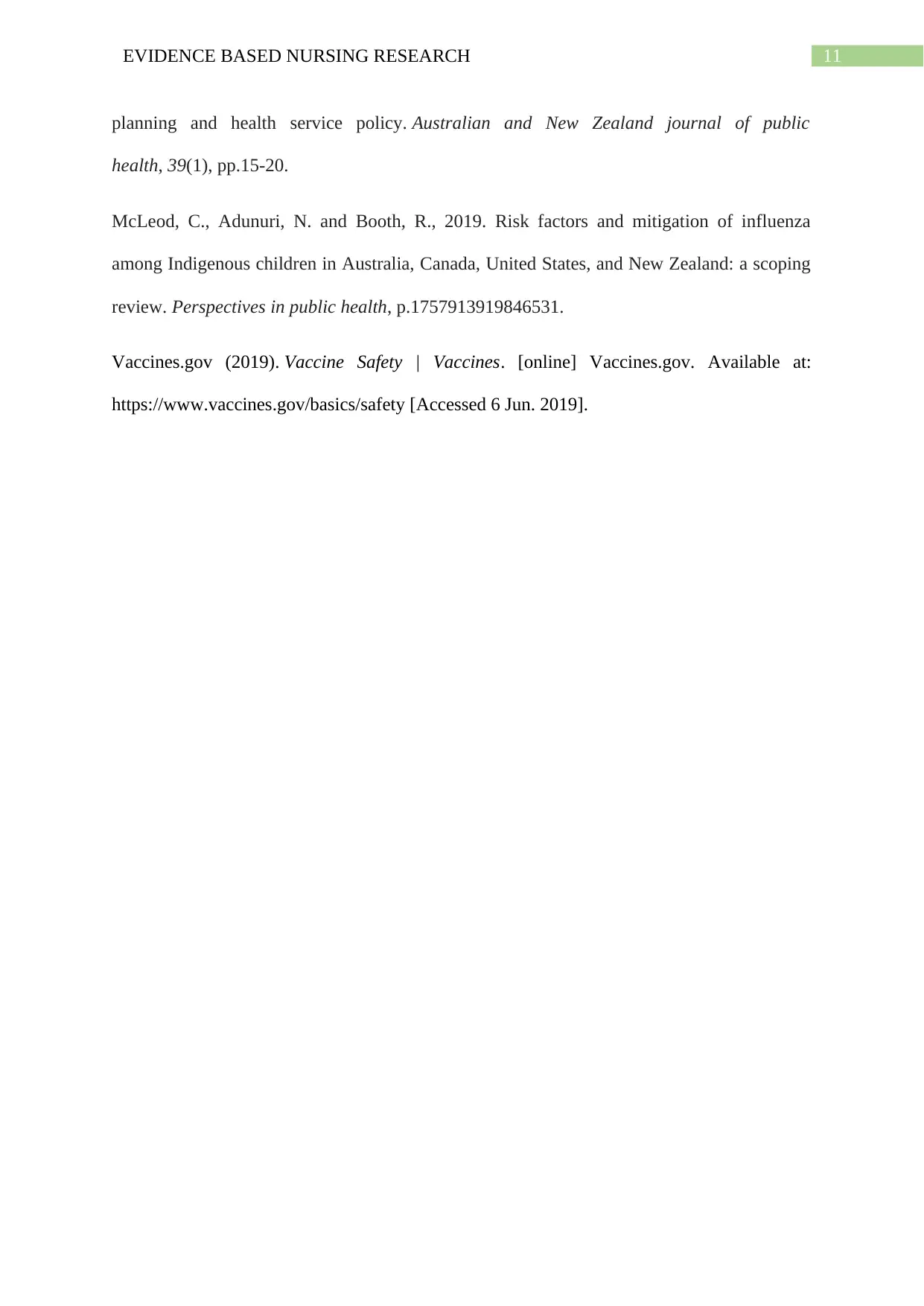
11EVIDENCE BASED NURSING RESEARCH
planning and health service policy. Australian and New Zealand journal of public
health, 39(1), pp.15-20.
McLeod, C., Adunuri, N. and Booth, R., 2019. Risk factors and mitigation of influenza
among Indigenous children in Australia, Canada, United States, and New Zealand: a scoping
review. Perspectives in public health, p.1757913919846531.
Vaccines.gov (2019). Vaccine Safety | Vaccines. [online] Vaccines.gov. Available at:
https://www.vaccines.gov/basics/safety [Accessed 6 Jun. 2019].
planning and health service policy. Australian and New Zealand journal of public
health, 39(1), pp.15-20.
McLeod, C., Adunuri, N. and Booth, R., 2019. Risk factors and mitigation of influenza
among Indigenous children in Australia, Canada, United States, and New Zealand: a scoping
review. Perspectives in public health, p.1757913919846531.
Vaccines.gov (2019). Vaccine Safety | Vaccines. [online] Vaccines.gov. Available at:
https://www.vaccines.gov/basics/safety [Accessed 6 Jun. 2019].
1 out of 12
Related Documents
Your All-in-One AI-Powered Toolkit for Academic Success.
+13062052269
info@desklib.com
Available 24*7 on WhatsApp / Email
![[object Object]](/_next/static/media/star-bottom.7253800d.svg)
Unlock your academic potential
© 2024 | Zucol Services PVT LTD | All rights reserved.





